#setting guide
Explore tagged Tumblr posts
Text
What does a setting book need to do?
So, I'm looking at this from my current experience with Dragon Age. I own pretty much everything that came out for the line plus two books supposed to "detail the world" not associated with the TTRPG. Let me just say, they do nothing of the sorts.
Or rather: They all do the same thing over and over again. They give us shorthand descriptions for all regions of Thedas, suggestive art, then leave us to color the rest in. You could almost say: They give us nothing.
I have spent significant time researching the internet on various topics about the world instead of using the books, as people have at least documented the game world from the computer games. And those Wikis are a better source than what Green Ronin gave us.

(Also, when looking for a GIF to show, tumblr directed me to a place to get help. I don't feel that badly about anything related to RPGs, thankfully!)
What I really needed
It didn't describe a single town or city in Ferelden, arguably the main focal point of the setting. The massive game book, which clocks in at 441 pages, devotes an entire paragraph to what a Ferelden city might look like. Places will usually get descriptions in the adventures published with the game - and ironically, those don't appear on the map.
So I designed my own place, Yerenburg, a walled city guarding the mountain passes that will connect the south of Ferelden to Orlais.
I simply needed a place where to locate my next adventure in the campaign, a mixture of two plots. I needed names (city, taverns, inn, streets), then some faction-related NPCs (I created an exclave of dwarven refugees which plays a role in plot B, so factions were important). Basically, a dot on the map and some basic description of the place and its role would have already sufficed to slot my idea in the game world. Dragon Age doesn't even have that.
Ideally, a setting description would provide the following:
A map with some major and minor places in a given land.
A general description of what places are like in the setting.
For each (major) place listed in the map it should give something unique that sets it apart from the general description - landmarks, the layout, local variations. These obviously should include names the GM can use to make the area come alive.
NPCs or factions that might be important to understanding the area, like a major local sect or a gang running things. At the very least who's in power and by what dynamic, and hopefully what challenges this power.
Some plot hooks. These don't need to be long or elaborate, they just get things going.
While I can certainly do with less on my own, one can safely assume, even for places features in video games, that most players know nothing. You are the world for them, their eyes and other senses. The combination of your descriptions either fills in the blanks - or overrides their misconceptions.
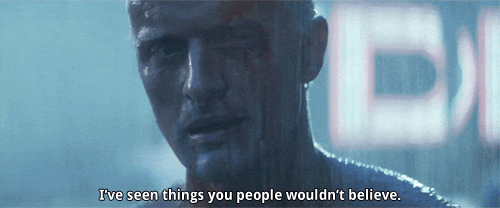
If you can't conjure it before your own inner mind eye, you can't describe it to others. Art can help, but the reality is that you need to fill in a lot of blanks still, and here the things above will help. You need a visual idea combined with some understanding of how the place works.
Ways of doing this right
I'll give you two examples of published products that have done this really well - the "Ninth World Guidebook" for Numenera and "Curse of Strahd" for D&D 5e.
The "Ninth World Guidebook" (NWG) is probably one of the best examples of a setting book there is - it really makes the setting of Numenera come alive - which is no small feat. A diverse world built on many previous ruined worlds of science fantasy, each unlike the other. And since it doesn't rely on some other product (movie or video game) to do its worldbuilding, it needs to get the job done so that the Ninth World in its messy and unpredictable nature comes alive to you. And it lives up to the challenge!
It gives you a feel for each region - and breaks the map down into distinct ones. The unique sites and cultures it lists are endless. It leaves you room to color in, but each region will have something that players will remember. It's a treasure trove of fantastic things.
And I don't even like Numenera! The system itself is rather flawed, but when it comes to the setting - and describing it - it wins hands down over any contender.
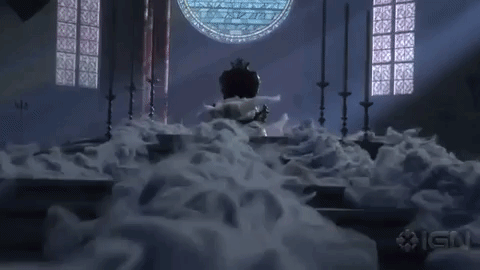
"The Curse of Strahd" is of course a full campaign/sandbox, not a setting book as such, but it still does marvelously well at putting together the lands of Barovia and making various places distinct. Each place has its own story, and so you can rely on a theme when setting interactions there.
Frankly, it stands apart from all other D&D campaign/adventures for 5e in this regard, as it is a marvelous balance of focused and broad, of detail and broad strokes. I ran part of a campaign in there, and it was never boring. There's plenty of detail you can miss as a player, stuff you can fail to encounter or figure out. You can dig deeper. But as a GM you also have the feeling that you have a great set of pieces that you can play with.
Now, not all locations are super-great, and the adventure only works if you don't play Strahd too smart, but I had my players on their toes. As it should be. And I never wondered how to present a place or convey the tone.
Conclusion
So, when publishing a setting of your own, or when making a setting only for yourself to use, think of these things. I have to remind myself, too. Why did I put this on the map? How does it feel to me? What's different? Is it just more of the same? I had to ask myself these things when putting down a broad strokes setting document for an upcoming sword & sorcery campaign.
A full setting book is a play aid, not something that can be done in broad strokes only. This is the meat for your adventure builders. The adventures written for Dragon Age show that the makers of the game had a good idea of how to make things for the setting, but they leave it to you to figure out details from their own written adventures. It lacks a "this is how it's done" kind of guide to put things together in the same way.
Given that often all we get is a rulebook and a setting guide, or, at best, a few adventures, I would hope that setting guides at least would live up to these standards.
0 notes
Text

"Did you think you could escape me, pet?"
1K notes
·
View notes
Text






Full (mad scientist) character portraits for WWDITS Season 6, shared by TV Insider!
#harvey guillén#harvey guillen#guillermo de la cruz#wwdits#what we do in the shadows#wwdits season 6#nandor the relentless#nadja of antipaxos#laszlo cravensworth#the guide#colin robinson#kayvan novak#natasia demetriou#matt berry#kristen schaal#mark proksch#september 2024#set photos
4K notes
·
View notes
Text
Danny is a damn good mechanic. Working on his parents automobiles have made how he works on vehicles a bit unorthodox. Why disassemble half of the entire car to get to the battery when you could just go in intangibly? OSHA is a scam and a fraud. So what if Nightwing sees him put tension on some coil springs he needs to add back to a cars suspension BY HAND BY SQUISHING IT DOWN and using safety squints while he secures everything in place. He also can MacGyver up absolutely anything you’ll ever need and anything you never should ever attach to your vehicle. All he asks is that no one ever repairs that part besides himself till the end of time or risk a chance of the item exploding in your face. Is it made out of half a toaster and a raspberry pi? Yes. It can however allow you to see the real time positions of any cop within 25 miles and that’s worth rapid disassembly.
#dpxdc#danny phantom#dp x dc#bones prompts#this is based off of a TikTok I saw from someone who used A FUCKING CLAMP TO PUT TENSION ON A COIL SPRING. MADE A STEEL GUIDE FOR THE#COIL TO GO INTO AND JUST SET IT ONTO THE PROPER PARTS AND SECURED IT#I’ve seen videos of people losing limbs from those things rapidly releasing all tension#and that was buckwild#anyways I love mechanic AU’s but no one writes them but god I try to make it a thing
917 notes
·
View notes
Text
Changing the Lore of Old Worlds
My Thought is simple - do not be so stringent.
Ownership is often a grey area for players of TTRPGs when they begin playing in a built setting. Settings like those I described last time, whether Dark Sun’s Athas or Planescape’s City of Doors, we hold rather tightly onto the book’s descriptions; sometimes at the expense of fun.
But we also don’t own that world - right? Someone else has crafted it and handed it down to us. But that is the thing - they handed it to us. Goblin, elves, halflings, trolls and ogres alike, they have handed it to us and now - IT IS OURS. As soon as the cash register closes and the proof of purchase is passed, the world does not belong to Wizards of the Coast nor to the authors and writers of whatever ttrpg - it now belongs to you.
Being loose with the Lore is an important step, in my Thought, to making a place your own place. And so I think we should feel liberated to make it a home for our adventures. Whether it is the Athas of Dark Sun or the DragonLance canonical universe, Storytellers and their companions should feel liberated to explore, reshape, and mold the world they play in; including its history, lore, and cultures; in a manner that is fun and contributes to the co-creative nature of Role Playing Games. I am thankful for Athas, which I am currently Hermiting, because its game guides are open and loose with its Lore, admitting that its histories are vague and somewhat conjecture, freeing up players like myself to craft out the events that happened in that past at our own table with the freedom to do it as we please. Some will hold their source books for Greyhawk tightly as Science texts or Fantasy Bibles, but I recommend leaning into the grey in your Greyhawk and building out YOUR table’s Lore of Greyhawk.
But then again, you do you. If Greyhawk as it is suits you and your players and your stories, that is quite alright as well. But please, play liberated not constrained.
#modules#setting guide#ttrpg#dungeons & dragons#d&d 5e#dungeons and dragons#we like change#co creative spaces#adventures#punk#don't be so dogmatic
0 notes
Text
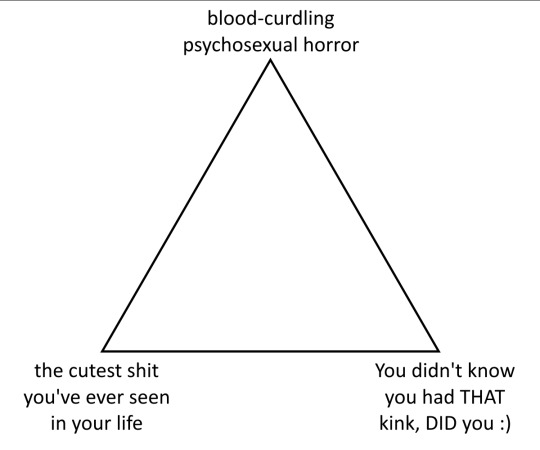
HDG story alignment chart
#bottom left: A Normal Grocery Run During Which No Domestication Occurs#top center: Sweet Poppy#bottom right: most of the setting honestly#HDG#human domestication guide#floretposting
2K notes
·
View notes
Text
Everyone Except For Siffrin Is Looping Au Except Someone Wishes That Siffrin Knew Everything There Was To Know About The Loops And Subsequently Accidently Replaces Their Non-Looping Siffrin With Post Game Canon Siffrin And They Only Find Out Cause Siffrin Gets The Memory Of Back In The Fucking Building Again.
#captain's posts#was this an elaborate set up for a joke? yes yes it was. was it also a legitimate au suggestion? yes yes it was. the duality of man ~(°^°)~#isat#in stars and time#isat au#in stars and time au#looping!Party:*wakes up in their designated areas* back on our bullshit here we go~#post canon!Siffrin:*wakes up in The Meadow™ after not looping for a year or so* F U C K#post-canon!Siffrin spends their first loop ignoring their problems and pretending like its all just a fucked up dream caused by stress#when in reality the looping party is Loop-less and instead summoned themselves a Siffrin that escaped the torture nexus to act as a guide
1K notes
·
View notes
Text
one of the things that continues to strike me on reread is how much the character of Darcy, and Austen through him, finds Mr. Bennet dead. And how much Elizabeth, in growing and changing and discarding her past blindness, has to move past her way of seeing her father and thus of seeing reality, because the two are connected! Darcy’s letter exposes her father’s flaws to Elizabeth in a way she’d never been able to see before. Most especially the way his laziness and neglect of his own gifts have hurt his family and that ultimately he doesn’t. care. Not enough to change. It literally says that she comes home from Hunsford and tries to laugh at her sisters’ and mother’s folly (the way she used to; the way her father has taught her to by example for her whole life) and she can’t anymore! It sticks in her throat. She is grieved by the failures that she sees in him, all the more so because she IS his favorite and she loves him! And the thing about Mr. Bennet is he never changes. The Lydia/wickham situation exposes to him sharply his own conduct and the consequences and he feels it! Because he is neither stupid nor unfeeling. But he, like everyone, has free will. And he chooses not to change when the opportunity presents itself. He even jokes about how quickly his feeling bad will pass and how soon everything will go back to normal, to his laziness and his selfishness. He is set in his ways and he serves as a contrast to Elizabeth’s personal journey because he embodies a version of a person she could have become and was in danger of becoming if her only goal at all times was to laugh at and judge people from the sidelines.
#pride and prejudice#I’ve always loved his character because he IS funny and he is iconic!!! and his love for Lizzy is touching!#he’s not faking it.#but he is so flawed. a man of taste a man of ability a man of judgment.#a man who could and SHOULD have set a different tone for his children and chose not to!#and they SUFFER FOR IT#their house is a divided one. and every child feels the pain of living in a house where the parents neither respect each other#nor are on the same team#there is a crack running through their house for this reason and it’s how Lydia (and Kitty) came to be so neglected!#who is going to discipline them or guide them? certainly not Mr. Bennet!#he’s so important to teach too. because the boys LOVE HIM. of course!#and are always very struck by his failures and laziness once I point it out#and yeah Darcy one of the only people who can expose him. because Darcy is putting in the work a man should be doing#Darcy’s house IS in order. his love is active and protective. he is fulfilling his role!#Mr. Bennet’s gifts are so extraordinary—the wit. the insight into human nature. honestly the capacity for wisdom#but he likes his library. he likes enjoying himself more than he likes doing his duty#as either a father or a husband#he does fail Mrs. Bennet! I have compassion for her there#anyway I love to think about this: something no version I have ever seen has ever fully explored#but man is it on the page#yeah yeah sorry for all the words. teacher off duty etc.
797 notes
·
View notes
Text
✧・゜: ✧how i use pinterest intentionally (not just endless scrolling) :・゜✧:・゜✧


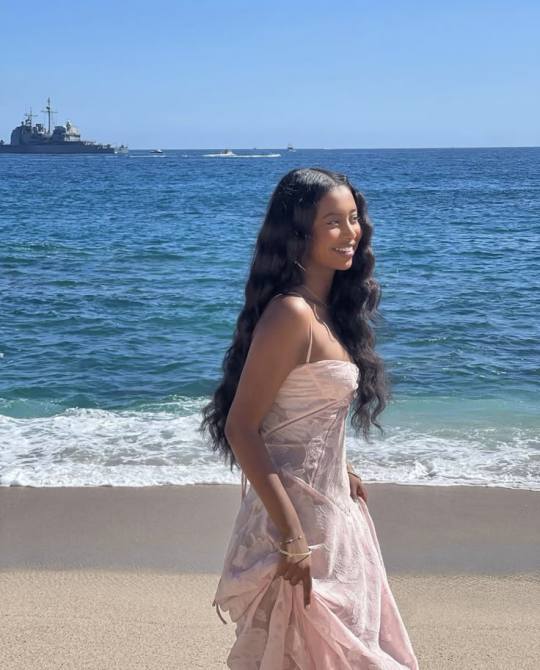
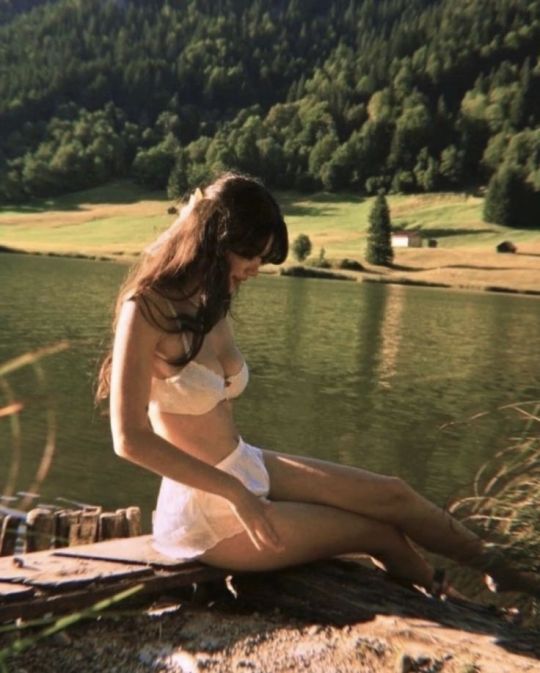

hey lovelies! ✨
confession time: i used to be a chronic pinterest scroller with absolutely nothing to show for my hours spent in the app. i'd save hundreds of pins to boards with vague names like "aesthetic" and "vibes," never to look at them again. sound familiar? but over the past year, i've completely transformed how i use pinterest from mindless consumption to an intentional tool that actually enhances my life. here's exactly how i made the shift!
⋆.ೃ࿔:・ the pinterest mindset shift ・:࿔ೃ.⋆
the game-changer for me was realizing that pinterest isn't just for collecting pretty pictures, it's a visual search engine and planning tool. now i approach it with purpose:
i ask myself "why am i opening this app right now?" before i even click the icon or enter it into the search bar
i set specific time limits for browsing (15-30 minutes max)
i focus on quality over quantity with my pins
i treat my boards as action plans, not just digital hoarding spaces
i regularly revisit and implement ideas from my boards
this shift transformed pinterest from a time-waster to one of my most valuable tools for planning, creativity, and personal growth.
⋆.ೃ࿔:・ my board organization system ・:࿔ೃ.⋆
the foundation of intentional pinterest use is thoughtful organization! here's my current system:
𝘮𝘢𝘴𝘵𝘦𝘳 𝘤𝘢𝘵𝘦𝘨𝘰𝘳𝘪𝘦𝘴: i group my boards into categories using board covers in the same color palette (lifestyle, home, fashion, etc.)
𝘢𝘤𝘵𝘪𝘰𝘯𝘢𝘣𝘭𝘦 𝘯𝘢𝘮𝘪𝘯𝘨: instead of vague names, i use specific titles like "meals for busy weeknights" or "bedroom refresh ideas 2025"
𝘴𝘦𝘤𝘵𝘪𝘰𝘯𝘴 𝘸𝘪𝘵𝘩𝘪𝘯 𝘣𝘰𝘢𝘳𝘥𝘴: i break down larger boards into sections (my "morning routine" board has sections for drinks, movement, journaling, etc.)
𝘱𝘳𝘪𝘷𝘢𝘵𝘦 𝘷𝘴. 𝘱𝘶𝘣𝘭𝘪𝘤: i keep boards private when they're in planning stages, then make them public once they're curated
𝘴𝘦𝘢𝘴𝘰𝘯𝘢𝘭 𝘢𝘳𝘤𝘩𝘪𝘷𝘪𝘯𝘨: i archive boards that aren't currently relevant (like christmas decor in july) to reduce visual clutter
⋆.ೃ࿔:・ my favorite intentional board types ・:࿔ೃ.⋆
here are the board categories that have added genuine value to my life:
𝘱𝘳𝘰𝘫𝘦𝘤𝘵-𝘴𝘱𝘦𝘤𝘪𝘧𝘪𝘤 𝘣𝘰𝘢𝘳𝘥𝘴: whenever i start a new project (room redecoration, event planning, etc.), i create a dedicated board with sections for different aspects
𝘴𝘦𝘢𝘴𝘰𝘯𝘢𝘭 𝘪𝘯𝘵𝘦𝘯𝘵𝘪𝘰𝘯 𝘣𝘰𝘢𝘳𝘥𝘴: i create a fresh board each season with sections for recipes, activities, outfits, and decor i want to incorporate
𝘤𝘢𝘱𝘴𝘶𝘭𝘦 𝘸𝘢𝘳𝘥𝘳𝘰𝘣𝘦 𝘱𝘭𝘢𝘯𝘯𝘪𝘯𝘨: i pin actual items i own alongside new pieces i'm considering to visualize combinations
𝘮𝘦𝘢𝘭 𝘱𝘭𝘢𝘯𝘯𝘪𝘯𝘨 𝘴𝘺𝘴𝘵𝘦𝘮: i maintain boards for different meal categories and actually reference them when making grocery lists
𝘨𝘪𝘧𝘵 𝘪𝘥𝘦𝘢𝘴: i have a board for each important person in my life where i pin potential gifts year-round
𝘨𝘰𝘢𝘭 𝘷𝘪𝘴𝘶𝘢𝘭𝘪𝘻𝘢𝘵𝘪𝘰𝘯: i create boards for specific goals with both inspiration and actionable steps
⋆.ೃ࿔:・ my pinterest workflow ・:࿔ೃ.⋆
this is my personal step-by-step process for intentional pinning:
𝘴𝘦𝘵 𝘢 𝘤𝘭𝘦𝘢𝘳 𝘱𝘶𝘳𝘱𝘰𝘴𝘦: i decide what specific question i'm trying to answer or problem i'm trying to solve
𝘤𝘳𝘦𝘢𝘵𝘦 𝘢 𝘴𝘦𝘢𝘳𝘤𝘩 𝘴𝘵𝘳𝘢𝘵𝘦𝘨𝘺: i use specific search terms rather than browsing the home feed (which is designed for endless scrolling)
𝘤𝘶𝘳𝘢𝘵𝘦 𝘤𝘢𝘳𝘦𝘧𝘶𝘭𝘭𝘺: i only save pins that: • provide clear value or inspiration • lead to actual content (not dead links) • represent ideas i genuinely might implement
𝘢𝘥𝘥 𝘯𝘰𝘵𝘦𝘴: i write specific notes on pins about why i saved them or how i plan to use the idea
𝘪𝘮𝘱𝘭𝘦𝘮𝘦𝘯𝘵𝘢𝘵𝘪𝘰𝘯 𝘱𝘭𝘢𝘯𝘯𝘪𝘯𝘨: after a pinning session, i schedule time to actually try one of the ideas
⋆.ೃ࿔:・ from virtual to reality ・:࿔ೃ.⋆
the most important part of intentional pinterest use is implementation! here's how i ensure my pins actually translate to real life:
𝘸𝘦𝘦𝘬𝘭𝘺 𝘱𝘪𝘯 𝘳𝘦𝘷𝘪𝘦𝘸: every sunday, i spend 10 minutes reviewing recent pins and selecting 1-3 to implement that week
𝘱𝘪𝘯-𝘵𝘰-𝘢𝘤𝘵𝘪𝘰𝘯 𝘵𝘳𝘢𝘤𝘬𝘦𝘳: i keep a simple journal noting which pins i've actually implemented
𝘱𝘩𝘰𝘵𝘰 𝘥𝘰𝘤𝘶𝘮𝘦𝘯𝘵𝘢𝘵𝘪𝘰𝘯: i take photos of my real-life versions of pinterest inspiration
𝘳𝘦𝘢𝘭𝘪𝘵𝘺 𝘤𝘩𝘦𝘤𝘬𝘴: i regularly ask "do i have the time/budget/skills for this?" before saving aspirational pins
𝘴𝘦𝘢𝘴𝘰𝘯𝘢𝘭 𝘤𝘭𝘦𝘢𝘯𝘰𝘶𝘵: i remove pins that no longer feel aligned with my taste or goals
⋆.ೃ࿔:・ advanced pinterest strategies ・:࿔ೃ.⋆
once you've mastered the basics, these strategies take intentional pinning to the next level! i hope you all enjoy them!:
𝘨𝘳𝘰𝘶𝘱 𝘣𝘰𝘢𝘳𝘥𝘴: i create collaborative boards with friends for shared projects or trips
𝘱𝘪𝘯 𝘮𝘢𝘱𝘱𝘪𝘯𝘨: for complex projects, i create flow charts showing how different pins connect to each other
𝘪𝘥𝘦𝘢 𝘦𝘷𝘰𝘭𝘶𝘵𝘪𝘰𝘯 𝘣𝘰𝘢𝘳𝘥𝘴: i document my own progress by pinning "before" and "after" images of my projects
𝘤𝘰𝘯𝘵𝘦𝘯𝘵 𝘤𝘢𝘭𝘦𝘯𝘥𝘢𝘳: i use pinterest to plan content themes for my blog and social media (i of course also use pinterest for images for my blog)
𝘭𝘦𝘢𝘳𝘯𝘪𝘯𝘨 𝘱𝘢𝘵𝘩𝘸𝘢𝘺𝘴: i create sequential boards that build skills in a particular area
⋆.ೃ࿔:・ final thoughts ・:࿔ೃ.⋆
pinterest is whatever you make of it, it can be a mindless scroll hole or one of the most powerful tools for intentional living and creativity. the difference lies entirely in how you approach it.
i still enjoy the occasional aimless browsing session (we all need that sometimes!), but transforming most of my pinterest time into purposeful searching and planning has genuinely enhanced my life. my spaces are more cohesve, my wardrobe more intentional, and my creative projects more focused, all because i stopped treating pinterest like social media and started using it like the powerful visual tool it truly is.
how do you use pinterest? are you a careful curator or a joyful browser? feel free to drop your thoughts in the notes!
xoxo, mindy 🤍

#pinterest tips#pinterest organization#pinterest aesthetic#girl tips#productivity hack#pinterest for planning#pinterest workflow#digital organization#pinterest boards#pinterest strategy#aesthetic organization#intentional living#pinterest inspo#productivity tips#pinterest guide#pinterest board ideas#pinterest hacks#aesthetic planning#pinterest tutorial#intention setting#coquette planning#aesthetic productivity#digital declutter#organization tips#pinterest board organization#girly productivity#that girl tips#pinterest sections#visual planning#digital planning
124 notes
·
View notes
Text
also ik I'm just a porn blog but given the recent political climate of tumblr I am once again encouraging y'all to back up your blogs especially if you're black or trans or fat or especially especially any combination of the above, ban waves will likely be coming soon but the damage is preventable if you back shit up. cebtenzzre's tumblr-utils is my preferred option for doing this if you know your way around a terminal but there are other options with less technical knowledge required.
#considering writing up a guide for doing this to make backups more accessible but in the meantime#mutuals pls DM me if you need a hand with setting up / running backups#nixie is normal#nixie yaps
161 notes
·
View notes
Text

me: I'm not a bat
Mr pages: (stuffing novels under its robe): I must abscond
#I have a lot of other bits I've collected but don't want to overwhelm the tag#I really would suggest motr and to play it as like. I like it for giving us a day to day slightly more grounded neath life#I think fallen london is a great setting well conveyed in total but motr is way more fleshed out in a “you're just a guy” way#I also really like the character writing. The gameplay to solve the mysteries is quite obtuse in total but I used a hint guide so it was#I knew what to do bc I would NOT have succeeded otherwise. But experiencing it was still fun#I'm quite torn on how good an intro it is for FL. I think that depends on your genre of choice but as a world introduction...#Idk!! In theory it's probably good. But I'd need to hear from people who went through it as their first to say. It touches on a bit of it a#Mask of the rose spoilers#Fallen london#for virginia and milton teaming up to bully you + mr pages ridiuclous comedy of a life it's worth it to me
280 notes
·
View notes
Text
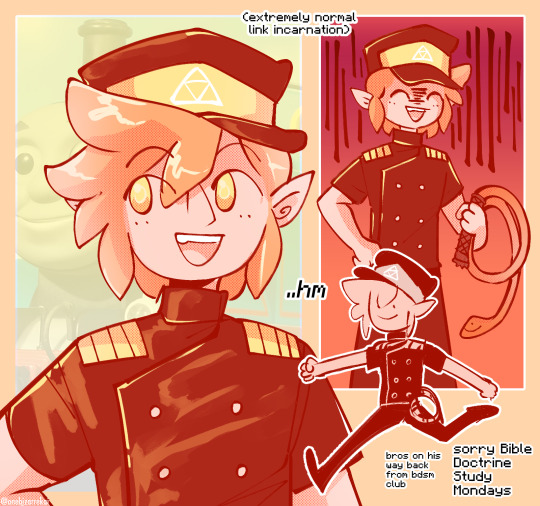
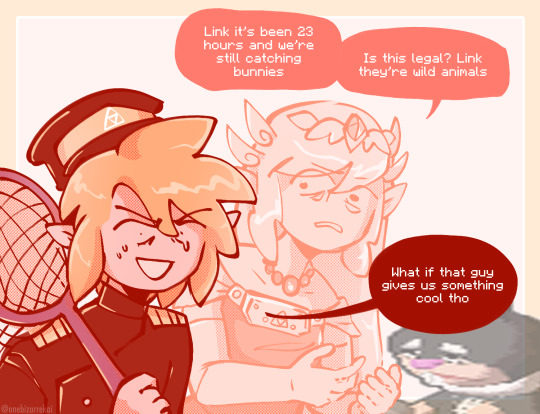
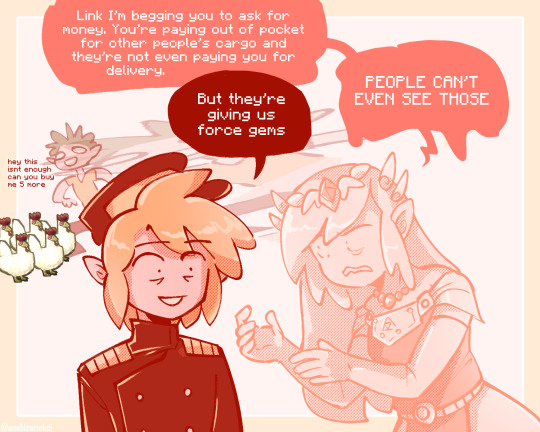

spirit tracks 100% completion has broken me
#legend of zelda#spirit tracks#link#zelda#nintendo#art closet#listen though. the 100% makes this game go from “ride your train in circles for 40% of the game”#to “ride your train in circles for 90% of the game”#this game's fast travel is terrible it's unhinged#I can't even imagine trying to 100% this game without a guide with how long it takes to go anywhere#also rng treasure……… almost all the train sets give you the same health…… it's nuts……
186 notes
·
View notes
Text
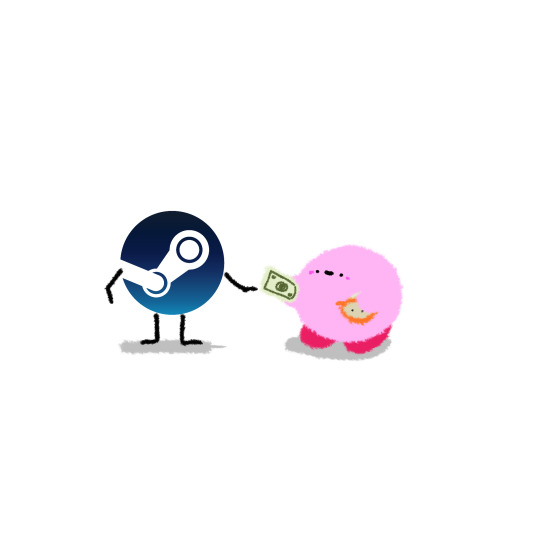
#kirby#daily kirby#my art#digital#hal laboratory#nintendo#waddle dee#(sort of)#one of my christmas presents was my wife's old desktop computer that she'd beefed up for video games#a while ago granted but still#so I did some more work on getting it set up today and then spent 5 hours playing house flipper :)#big kid computer means I can actually play pc games again#beyond full perfecting cook serve delicious on low graphics lol#also I knew my brother had given me a yakuza game a while ago that I hadn't opened because I was still on my laptop#but it turns out he gave me two yakuza games#so once I get the controller set up I can play yakuza 2 also!#I really enjoyed yakuza 1 except for a couple bs sections in the story and the very very last side mission.#(having a more powerful computer also means once I get the peripherals squared away I can start video captioning)#(and maybe hopefully stream occasionally)#(I really wanna stream my partner playing ace attorney because I want to have his reactions on record for myself lol)#(he loves puzzles and he grew up in the moon logic video game days and he has some background in criminology)#(so either he'll get super into it or he'll absolutely hate it I think lol)#(I've done a very good job of not spoiling anything)#(I know the court segments well but I might keep a guide on the side for the investigation segments)#(I never had that much trouble with them tho cuz I tend to be thorough and methodical)
206 notes
·
View notes
Text















Behind the scenes photos featured in Vulture's WWDITS set visit and final season preview!
#harvey guillén#harvey guillen#wwdits#what we do in the shadows#wwdits season 6#wwdits spoilers#guillermo de la cruz#nandor the relentless#laszlo cravensworth#nadja of antipaxos#the guide#colin robinson#kayvan novak#matt berry#natasia demetriou#mark proksch#mike o'brien#jerry the vampire#behind the scenes#set photos#october 2024#vulture
1K notes
·
View notes
Text

pov: eon tries to explain why eating a star was a good idea, [eon design by @the-bitter-ocean]
bonus:
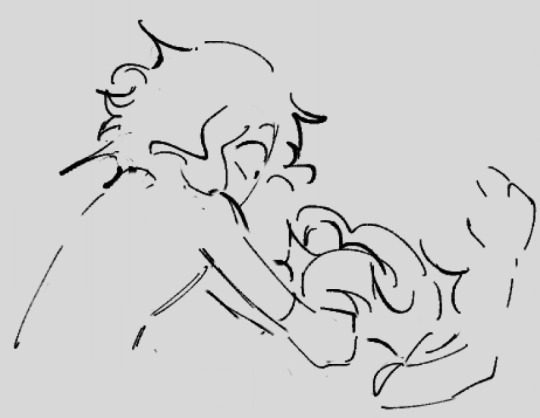
#the consequences of your actions#in stars and time#isat#isat spoilers#a6se spoilers#isat odile#isat loop#odile loops au#set in: bonnie loops; eon and loop as guides#''look if wish craft trapped us in the loops then wish craft is the way to get out of it. the logic tracks. the loops going over-#to boniface; was in fact; not supposed to happen;''#loop beefing with eon will never be not funny to me#day 85#That's probably enough eon for now; back to working on asks#isat au
480 notes
·
View notes
Text
Muntan Mine: An Abbreviated Sword & Backpack Setting Guide
Muntan Mine is a beautiful mine home to Dwarves, Gnomes, Goblins, a few scattered orcs, and Dark Elves. Dwarves and Goblins do not get along too well and tend to stay separated (it is not a stereotype, it is an attempt to be true to life). Gnomes play much of the middle and the Dark Elves tend to come and go from the under dark to us, as a sort of tradesman.
Brunehilde is the local dwarven librarian. She guards the tomes preciously and adventurers looking for consistent spell materials will find her reluctant to let you write down anything they have or take it away from the sacred walls of that place. Her cat, seven feet in height and five hundred pounds, is also reluctant to let you do so.
Morik Skullthank is the Tavern keeper, a lovely Goblin with a kind heart and a brutish smile. He enjoys singing the classics and making apple cider. He may send you out into the outside for supplies, but be careful because there are wild beasts out there - from small dragons to large bears, perhaps even a Kobold tribe here or there to watch out for.
Most people in town dig in the mines or fashion materials into useful things. Hunters are those in charge of leaving the mines to forage for food and catch game; a good group to join if you want to explore the Mountainside. But the constant mining also means there are many abandon mines that may need to be cleared out - the Cranks handle that. They are named for Huberis Crank, a Gnome Lord, who started the Guild and takes payment to clear out pesky mines. They are profitable, but pay a wage rather than letting you keep treasures you may find. May be best to go out alone, but it is far more dangerous and the Cranks don’t take well to doing so.
Most of the frustrations of the town surface between conflicts related to the two most socially powerful families, the Orinrigs [Dwarves] and the Stenak [Goblins]. The Stenak are in charge of the Mine Guard, like a police of sorts, but also in charge of keeping dangerous things away. And the Orinrigs are the counters, the ones who disperse the food and other sorts of resources, and keep track of them. The two hate one another, and I dare say things even get violent if they can find someone to do their malicious dirty work.
Oh, and don’t mind Sal - he just trades things and, sometimes when he is low on cash, he may steal something. But he is a nice man and worthy of your time in conversation. He comes and goes. Don’t drink anything he gives you, it will give you dark vision but take your day vision! He has the best things to sell otherwise; as Dark Elves often do.
#sword and backpack#ttrpg#dungeons and dragons#tabletop#roleplaying game#adventure#setting guide#supplements#rpg supplements#you have to love an underground mine
0 notes